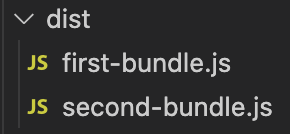Webpack needs to store the bundle file that it created in some location. Webpack also needs to give proper file names to the bundle file to manage caching. Both these functionalities can be managed using output configuration.
Default value of
outputconfiguration is./dist/main.js.
Setting output
If we want to store our bundle file as jam.js under jim folder, we need to add the output config to webpack.config.js as below.
const path = require("path");
module.exports = {
output: {
path: path.resolve(__dirname, "jim"),
filename: "jam.js",
},
};The value of output always need to be an object. We CANNOT give the path as a string("./jim/jam.js").
Also the path property requires an absolute path. That is why, we have to import path package to resolve the absolute path. path package is part of Node.js and therefore we do not have to install it separately.
If we are setting
outputconfig, the only mandatory property isfilename. Webpack will then create the bundle in./distfolder, with the provided file name.
Multiple Entry Points
We learned about multiple entry points in Webpack entry config article. Here we have a webpack.config.js file that handles multiple entry points.
module.exports = {
entry: {
first: "./src/first.js",
second: "./src/second.js",
},
output: {
filename: "bundle.js",
},
};Here, we explicitly mentioned that the output bundle file name should be bundle.js. But, since there are two entry points, there will be two output bundles. So, how can two bundles have the same name? That is not possible. That is why, if we try to run webpack with above configuration, we will face below error:
Error: Conflict: Multiple chunks emit assets to the same filename bundle.js (chunks first and second)Our expectation is that, webpack will create first-bundle.js and second-bundle.js under ./dist folder. For that, we can make use of [name] placeholder to provide dynamic naming to output files based on entry points. Here is how the updated config file looks like.
module.exports = {
entry: {
first: "./src/first.js",
second: "./src/second.js",
},
output: {
filename: "[name]-bundle.js", },
};We can see from the webpack logs that first-bundle.js and second-bundle.js are emitted. See the green colored text below.

Now, if we check the dist folder, we can see the two bundle files as expected.

Hope you understood how Webpack output config works.
